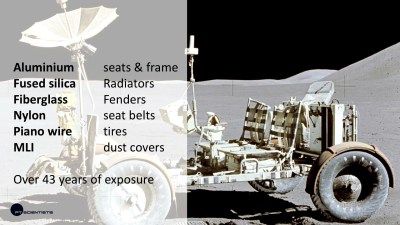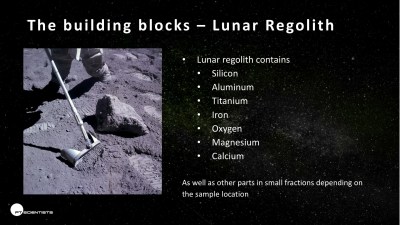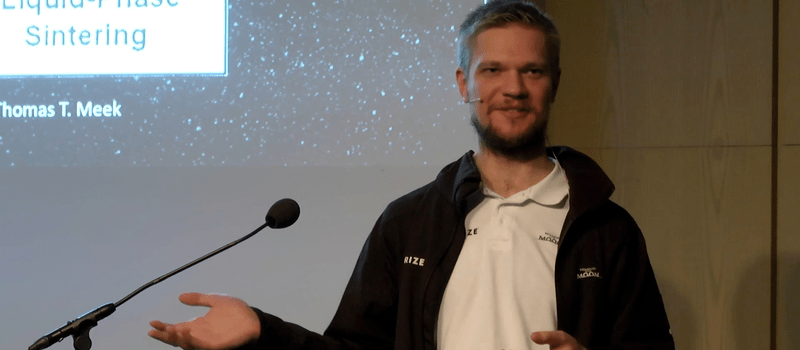How do you resist this talk title? You can’t! [Karsten Becker]’s talk about what kinds of 3D printers you’d use on the moon is a must-see.
[Part-Time Scientists] was a group of 35 people working on a mission to the moon. Then they won the qualifying round in the Google Lunar XPRIZE, got a bunch of money, and partnered with some heavy corporate sponsors, among which is Audi. Now they’ve added eleven full-time employees and updated the name to [PT Scientists]. (They’re taking applications if you’re interested in helping out!)
 A really neat part of their planned mission is to land near the Apollo 17 landing site, which will let them check up on the old lunar rover that NASA left up there last time. The science here is that, 45 years on, they hope to learn how all of the various materials that make up the rover have held up over time.
A really neat part of their planned mission is to land near the Apollo 17 landing site, which will let them check up on the old lunar rover that NASA left up there last time. The science here is that, 45 years on, they hope to learn how all of the various materials that make up the rover have held up over time.
But the main attraction of their mission is experimental 3D printing using in-situ materials. As [Karsten] says, “3D printing is hard…but we want to do it on the moon anyway.”
 One idea is to essentially microwave the lunar regolith (and melt it) . This should work because there’s a decent iron component in the regolith, so if they can heat it up it should fuse. The catch with microwaving is directivity — it’s hard to make fine details. On the plus side, it should be easy to make structures similar to paved roads out of melted regolith. Microwave parts are robust and should hold up to launch, and microwaving is relatively energy efficient, so that’s what they’re going to go for.
One idea is to essentially microwave the lunar regolith (and melt it) . This should work because there’s a decent iron component in the regolith, so if they can heat it up it should fuse. The catch with microwaving is directivity — it’s hard to make fine details. On the plus side, it should be easy to make structures similar to paved roads out of melted regolith. Microwave parts are robust and should hold up to launch, and microwaving is relatively energy efficient, so that’s what they’re going to go for.
But there are other alternatives. The European Space Agency is planning to bring some epoxy-like binder along, and glue regolith together in layers like a terrestrial cement printer. The problem is, of course, schlepping all of the binder to the moon in the first place.
And then there are lasers. [Karsten] talked lasers down a little bit, because they’re not very energy efficient and the optics are fidgety — not something you’d like to be supporting remotely from earth.
The final option that [Karsten] mentioned was the possibility of using locally-generated thermite to fuse regolith. This has been tested out on earth, and should work. [Karsten] thought it was an interesting option, but balls of hot thermite are potentially tough on rovers, and the cost of mistakes are so high that they’re going to put that off for a future mission.
In the end, the presentation ran only thirty minutes long, so there’s a great Q&A session after that. Don’t go home once you hear the audience clapping!
















Sounds like this book from By Cory Doctorow http://boingboing.net/2015/05/22/the-man-who-sold-the-moon.html
People in Africa could’ve used that fusing methods to build real houses out of mud or sand.
There are much easier techniques to fuse mud, such as adobe brick making.
This some straw manure and clay. It pretty much is 3d printing with your hands.
Actually the easiest and most efficient method is to use the very intense solar energy as simple focus rays to melt the regolith. Solar 3d printing of sand is demonstrated on earth in this youtube video here http://www.youtube.com/watch?v=ptUj8JRAYu8
Using this proves in a vacuum such as we have on the moon would produce much stronger objects since they would retain their heat better for fusing to the next layer.
All manner of infrastructure could be built this way, not just roads.
I don’t know that it would retain the heat much better. Radiative heat loss goes up with the fourth power of the temperature, so as the temperature rises it becomes the dominant mechanism.
The phase transition temperature for fusing lunar regolith is a constant, so having only radiative heat loss in vacuum, or radiative and conductive heat loss in atmosphere, the first is still preferable. Also, for microwaving, the radiative heat loss is also present, but the optical energy can be focused much better…
And we can solve the radiative losses with a space blanket!
You could certainly send something similar in theory, but the problem is that is has to survive being launched. It’s even brought up in the Q&A segment.
And a quick reply to Artenz: you have radiative heat loss here on Earth as well, so it turns out that it is indeed easier to do in a vacuum (because no convection).
If on Earth, radiative heat loss accounts for 80%, then getting rid of convective heat loss only helps to remove the last 20%, which doesn’t make a huge difference.
Well, if you’re working within a mass constraint then 20% lower heat power means 20% lower lens area, which is certainly helpful :]
But beyond that you need some finicky optics that needs to be able to fold up and deploy and be adjustable.. it’s a hassle. Me and some friends who are somewhat involved in this project have given this quite a bit of thought, and anything beyond maybe a laser + galvos is going to be very tricky just from a mechanical standpoint. The microwave idea Karsten’s put forth sounds quite doable, especially if you can use the rover to move it around.
We are basically talking about making clunky fairly imprecise structural objects and components, right? Roadways, walls, bed frames, chairs, tables, storage units, meteor impact ablation mass, pressure vessel confinement and certain tools like hammers, levers and such.
A Fresnel lens would not be as heavy or prone to maintenance needs as other designs. One might even consider using memory muscle actuators for the xyz spotting to reduce problems from regolith dust (which gets into everything, grinding components to death).
There was an article here a few years ago, about a guy who built his own solar 3D printer, and took it into the desert. Managed to make rough bowls and the like, from sand / glass. Pretty sure the lenses were flat fresnel ones, maybe a square metre or so altogether, in 4 square lenses. The whole thing was on a sort of cart.
That might be nice on the Moon. Maybe no atmosphere would mean more sunlight, easier to focus. Maybe you could even do it from orbit, if it was a low enough, slow enough orbit. Or get robots to do it from ground level. Being able to make buildings, roads, etc. The glass was translucent, so you’d get natural light in your moon-dome. Even if you had to fix the place up a bit once you got there, having a bulk material that’s already there would be a great help. Repairs would be easy too, just re-melt any bits that crack.
Part of the problem with solar on the moon though is that it is pretty spotty in terms of coverage. You spend a significant part of each day in the shade of the Earth and then you also have the moons rotation. Plus if you try to drop down into a nice flat crater or near a mountain ridge you have that getting in the way. At least you can count out clouds I guess.
Lunar eclipses happen only 2-5 times per earth year. A lunar day lasts for approximately 2 weeks. If you wanted to get maximum benefit from solar energy you would set up production well away from ridges and mountain ranges. The side of the moon facing us has nice flat maria with no obstructions. With steerable optics (mirrors or lens) you could get pretty close to 2 weeks of energy even with the sun near the horizon because there is no atmosphere to reduce the amount of sunlight.
There is no point dropping a solar energy system onto the surface of the moon, it makes much more sense to utilise the Lagrange points with the larger first stage reflector stationed at L4 and or L3 and then the secondary/s at L1 and or L2. This gives you complete coverage of any point on the moons surface and the largest amount of concentrated sunlight for any given mass of reflector because orbital structures can be lighter.
The Lagrange points would be very good locations for beamed power generators to power ships all over the solar system. I doubt they would be directly useful for 3d printing objects on the moon other than roadways perhaps. Then too the 1st ones to talk about putting up such powerful potential death rays might find more than a few nations objecting to it.
Good luck getting large Fresnel lenses to the moon in one piece.
Why you no embed youtube?!
https://www.youtube.com/watch?v=tC_DVK3RfLU
I don’t know how.
Uh no you use none of those methods, you use a nuclear powered drilling machine that melts the walls of the bore… You need to go down to get out of the radiation not up. Then all you need to do is cap it.
https://en.wikipedia.org/wiki/Subterrene
Not to mention the nearly inexhaustible supply of helium 3 on the moon just use it to run a fusion drill. Rushing these technologies is akin to rushing wind power, as opposed to waiting for 30% efficient solar PV.
The concentration of He3 on the moon is actually very low, and the concentration of working He3 fusion reactors on the moon is even lower.
The concentration of working (in a usable way) fusion reactors is very low in our solar system. Not including some neutron sources, and our sun of course.
The point was that we don’t even have a working fusion reactor on earth, let alone one that can take He3 as fuel.
And when I see the size and mass of the current experimental fusion reactors, my first thought is not: “let’s strap that to a rocket, and send it to the moon”
I think solar panels would be a better way to get energy.
@ Artenz – I agree. Solar panels would be far less expensive to send to the moon.
Is the concentration of intelligent people working on fusion low? How many current working 3d printers are there on the moon?
Do you realize how much a gram of anuetronic fusion material is worth? Uranium-235 contains two to three million times the energy equivalent of oil. Deuterium Deuterium fusion has the equivalent of 1,897,389,192.5 gallons [U.S.] of gasoline with nasty free nuetrons. He 3 is similar in energy density.
This means if someone had enough money, they could start mining the moon right away and make a profit. And no you are wrong the concentration of he-3 is extremely high on the moon compared to everywhere else in our solar system. 50ppb in shaded regions is plenty to extract when drilling. You are super heating the rock anyway might as well suck up the helium.
that is 1 metric ton of D-D fusion to 1 metric ton oil…
Regardless all these fusable printing technologies should also be looking at capturing released he-3.
He3 is only worth money if it can be used to do something profitable. Extracting it, liquefying it, and sending it back to earth is not profitable, so that makes it only useful on the moon as a fuel source. Deuteron-triton fusion has greater potential for profit. Tritium is easily produced in even a small research reactor, and additional fuel can be breed by the neutron capture in lithium-6 or lithium-7 (depending on indecent neutron energy) in the reactor blanket. Tritium decays into He-3. 60,000 liters of He-3 were used in the US last year. It’s cost is about $2000 per liter (gas at STP) at the moment.
And, at this point in time, the equipment and infrastructure to support a fusion device of sufficient size to pass the break-even point is far beyond the total mass that could be sent to the moon even with 100 launches.
50 ppb means you have to dig up and process 20000 tons of regolith to produce 1 kilogram of He3. And such concentrations are only found in the surface layer of permanently shadowy areas, which means you have no convenient solar energy, and a major challenge to keep the machines working in the cold.
And 1 kilogram of He3 isn’t very much. If you used it to power the electricity usage of the USA, it would only last half an hour, so you’d have to mine about a million tons of good regolith per day to keep up with that.
You might be interested in a publication ACI released about 25 years ago regarding lunar concrete and cement production, SP-125: https://www.concrete.org/publications/internationalconcreteabstractsportal.aspx?m=results&Publication=Special+Publication&volume=125
Although not as cool sounding as 3d printing or lasers, I find the science of concrete just as interesting. A big problem with any production method listed here though is heat generation and removal of said heat in vacuum.
I am surprised there is no mention of electron beam melting. Electron beam melting is just like laser sintering except instead of using a laser you use an electron beam and instead of sintering you melt the powder. It’s more efficient than using lasers; a laser sintering machine running plastic takes as much energy per unit mass as an electron melting machine running titanium. Plus because you can scan an electron beam back and forth very fast, you can get much better thermal control(here’s an awesome video of this here: https://www.youtube.com/watch?v=Cqa3TMxje14). The cool part is that the moon is hard vacuum, so you don’t need a complex vacuum chamber and pump equipment like we need on Earth.
It’s more than hard enough vaccuum (2×10^-12 torr), but I’d consider a plasma window anyway. One bit of dust would ruin your visit. The issue with EBM is that it can and does make a wonderful high energy X-ray generator. Without proper shielding, anything near it would have to be hardened against a continuous solar flare, effectively.
The Moon’s regolith may be +4km thick but the list, easily fused, dust on the surface is only cm deep.
The moon is too dusty to paint “on” it.
Interesting, I like with your way of thinking